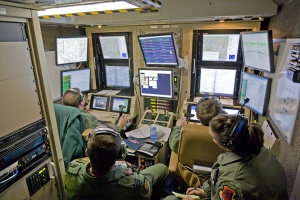
'GOING KINETIC' IN DRONE WARFARE
Drone Wars UK
Predator drone crew at Creech AFB
The concern that drones make armed attacks and military intervention more likely is often rejected by the military and the drone industry, who argue that the drone pilots are able to stand above the ‘fog and friction’ of the battlefield and to make dispassionate and rational decisions about whether or not to use ‘kinetic force’.
This argument, however, has been torn to shreds by the release of a mass of papers detailing the US military investigation into a massacre of Afghan civilian on 21st February 2010. The ‘incident’ as the papers describe the attack, took place on three vehicles near the village of Shahidi Hassas, Uruzgan district, Afghanistan. According to the US investigation 15 or 16 men were killed (they couldn’t tell because the bodies were so badly damaged) and 12 people were wounded, including a woman and three children. Elders from the Afghans’ home village, however said that 23 had been killed, including two boys, Daoud, 3, and Murtaza, 4.
While the investigation finds that several factors contributed overall to the tragedy, it makes it very clear that the attitude and actions of the Predator drone crew were a significant cause of the civilian deaths:
“The Predator crew demonstrated a propensity/bias for kinetic operations and failed to accurately pass Distributed Common Ground Systems (DCGS) Screeners [the analysts watching the live video feed from the drone] assessments to the [commander in the field] that could have prevented the strike. The Predator crew’s bias towards kinetic operations skewed their reports. The Predator crew emphasized information suggesting the vehicles were hostile, while downplaying or ignoring information to the contrary.” (Centcom FOIA 10-0218 Uruzgan , p.61)
Elsewhere in the papers, the investigator lays out in detail, using the audio logs of conversations from the drone pilots, how they “skewed” their reports towards an attack:
1: While the Screeners [analysts watching video feed} assessed the vehicles appeared to be attempting to egress the area, the Predator assessed the vehicles to be attempting to flank the ODA [soldiers in the area 5 miles away]
2: While the Screener identified children [in the vehicles] the Sensor Operator and the Pilot responded with “Bullshit”
3: The Predator pilot and crew constantly challenged the Screeners assessment whenever there was an indication that it may not have been a hostile target. “at least one child… Really? Assisting MAM [Military term meaning Military Aged Males] means he’s guilty…. Review that (expletive deleted). Why didn’t he ‘possible child’? Why are they so quick to call (expletive deleted) kids but not call (expletive deleted) a rifle”
4: The Predator pilot made the assessment that a scuffle with the target location was due to suing some passengers as a “human shield”. There was no basis or experience for this assessment.
5: After the initial strike, they identified the women on the objective as men in women’s clothes with earrings and jewellery. They refused to accept the fact there were women on the object.
6. There are any more examples through the internal [communications] transcript. What is most concerning is when you cross walk the transcript between the Screeners in Florida to the Predator pilot in Creech AFB Nevada, then crosswalk the actual transmission, between the predator pilot and the [commander of the US soldiers on the ground 5 miles away} it becomes clear that the predator Pilot and selected members of the crew independently skewed the ground picture.
Finally, target hand off between the predator crew and the OH-58D [the helicopter crew which launched the attack as they had more weapons than the Predator drone which was to attack "squirters" running from the vehicles] was lacking key information – there was no mention of adolescents by the Predator crew… The OH 58D pilots testified if they would have known f adolescents in the convoy they would not have engaged until cleared from their higher.” (Centcom FOIA 10-0218 Uruzgan , p.52/53)
Elsewhere the investigating officer makes clear that, except for the sergeant commanding the small force of soldiers on the ground some 5 miles away, “no one involved considered the males as civilians at any time” (Centcom FOIA 10-0218 Uruzgan , p.49) and later “even after the strike, adult males were reported as enemy killed in action despite the fact that no weapons or explosives were found.” (Centcom FOIA 10-0218 Uruzgan , p.38)
While it is not possible to say for certain, one wonders what would have happened if the Sergent commanding the small group of soldiers – who immediately reported possible civilian casualties – had not done so? How many other such ‘incidents’ have gone unreported and uninvestigated, and merely put down as insurgents killed in action?
According to the LA Times which reported the attack after seeing a summary of the investigation papers last year, the Predator crew were disciplined but the Air Force refused to reveal their specific punishment. The Pentagon however confirmed that no one faced a court-martial in relation to the attack.
This ‘propensity to kinetic action’ cannot be applied just to one lone Predator crew however. (It should be noted that a USAF Captain observing at Creech told the investigators that “there was a ‘Top Gun’ mentality amongst the Predator Crews.”) Rather it must be applied much wider as drones have enabled the US military to ’go kinetic’ further and further afield, and more and more often.
Yesterday, the Bureau of Investigative Journalism (TBIJ) reported that US drone attacks in Yemen have risen sharply over the past two years to the point where it is now at the same level of strikes as in Pakistan. TBIJ has painstakingly detailed a huge amount of covert US military involvement in Yemen over the past decade and amongst that, reports 20 confirmed, and a further 14 unconfirmed, strikes in Yemen over the past two years alone.
See this short AL Jazzera piece on the TBIJ report:
VIEW VIDEO
http://www.globalresearch.ca/index.php?context=va&aid=30034

